Military Aircraft Avionics Market Size
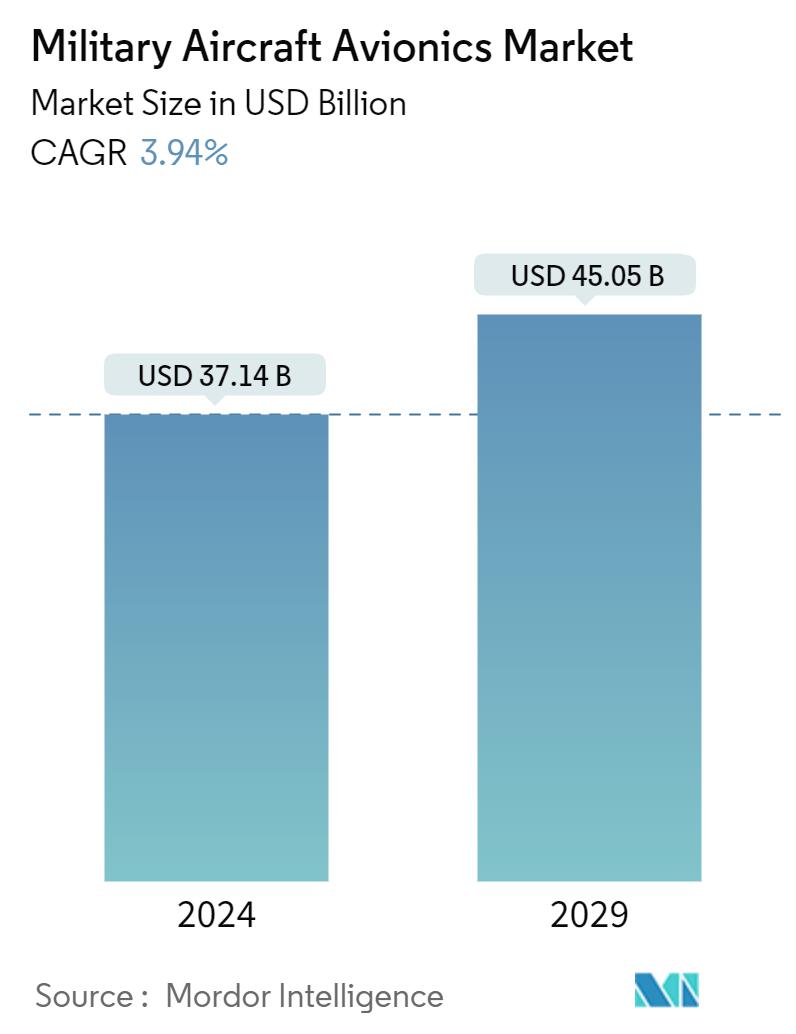
| Study Period | 2019 - 2029 |
| Market Size (2024) | USD 37.14 Billion |
| Market Size (2029) | USD 45.05 Billion |
| CAGR (2024 - 2029) | 3.94 % |
| Fastest Growing Market | Asia Pacific |
| Largest Market | North America |
Major Players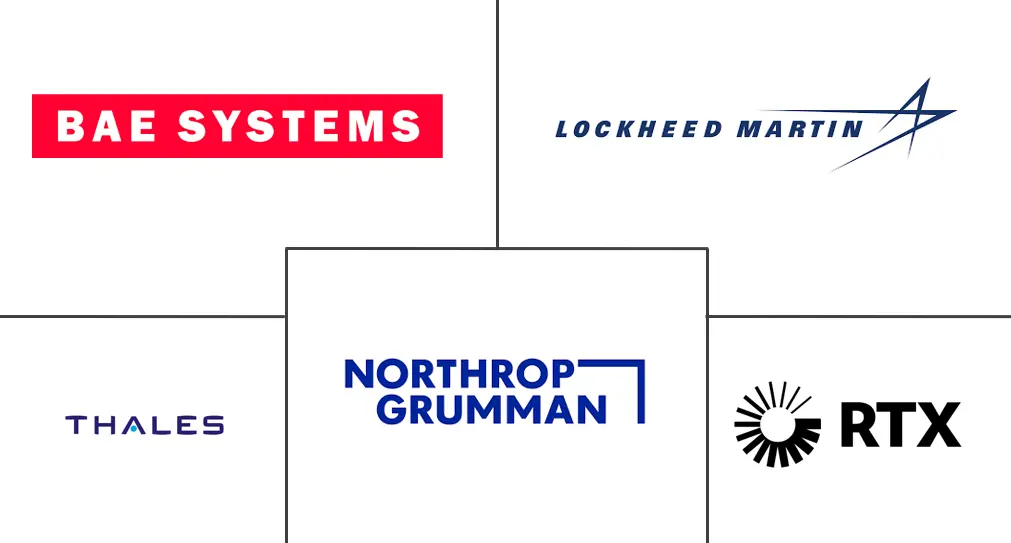
*Disclaimer: Major Players sorted in no particular order |
Military Aircraft Avionics Market Analysis
The Military Aircraft Avionics Market size is estimated at USD 37.14 billion in 2024, and is expected to reach USD 45.05 billion by 2029, growing at a CAGR of 3.94% during the forecast period (2024-2029).
Due to geopolitical tensions and border disputes, several countries worldwide are expediting their procurement of new military aircraft, helicopters, and drones, leading to a significant rise in military spending. Numerous nations are investing in modernizing their fleets with state-of-the-art equipment to bolster their aerial capabilities. These investments in the procurement and modernization of military aircraft are anticipated to drive market growth in the future.
The introduction of advanced avionics generates the need to replace old avionics systems in conventional military aircraft. These new avionics suites support the aircraft in meeting the new battlefield requirements, such as electronic warfare defense and long-distance target detection and tracking. Therefore, to stay abreast of adversaries, the defense forces plan to modernize the avionics in military aircraft. Various countries are procuring next-generation military aircraft to expand their fleets.
Various nations' rising demand for UAVs is driven by the increasing necessity to deploy them over hostile airspace, aiming to prevent any potential damage or danger to expensive manned aircraft. Besides their effectiveness in intelligence, surveillance, and reconnaissance (ISR) missions, UAVs can carry out combat target acquisition and search and rescue operations. The rising demand for UAVs is primarily motivated by the safety of crew members involved in non-combat missions. Additionally, the lower procurement cost of UAVs compared to traditional aircraft used for similar purposes has led to their increased acquisition by developing countries. However, challenges in certifications and integration of new hardware in advanced avionics systems hamper market growth. The changing nature of modern warfare, characterized by asymmetric threats and complex operational environments, necessitates the need for highly adaptable and flexible platforms. Such developments may create market opportunities in the future.
Military Aircraft Avionics Market Trends
The Flight Control Systems Segment to Dominate the Market During the Forecast Period
A military aircraft's flight control system (FCS) consists of hardware and software systems for cockpit flight controls, such as data acquisition systems, autopilot, flight recorders, active inceptor systems, and aircraft management computers. Currently, the flight control systems in military aircraft are developed based on fly-by-wire (FBW) technology. The rising geopolitical tensions across various regions have compelled defense forces to enhance their combat capabilities. Many countries have increased their defense budgets to strengthen their military capabilities, driving the demand for military aircraft and UAVs.
Additionally, aircraft OEMs have partnered with avionics OEMs to develop and equip advanced flight control systems in new-generation aircraft. Also, key players are focusing on integrating next-generation technologies such as big data analytics and artificial intelligence (AI) into computers to enhance the autonomous operations of human-crewed and uncrewed aircraft. For instance, in January 2023, France granted Thales and Sabena Technics a contract to upgrade the CN-235 military transport fleet of the French Air and Space Force. Once the upgrade is done, the CN-235 fleet will be operational through 2040. Similarly, in March 2024, Canada's Department of National Defence (DND) awarded Arcfield Canada a contract to provide avionics in-service support for the CF-18 fleet for USD 157 million. Such developments are expected to accelerate the market's growth during the forecast period.
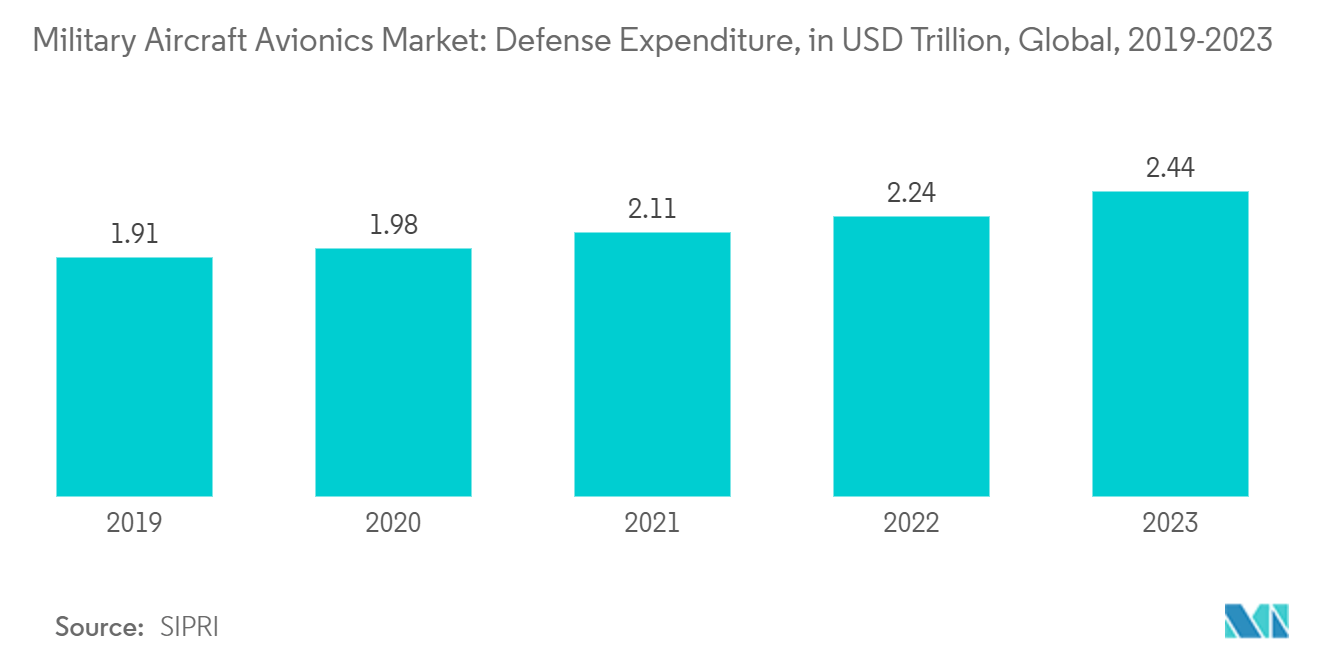
North America Expected to Exhibit the Largest Market Share During the Forecast Period
North America is expected to emerge as the dominant regional player in the market. The demand for military aircraft avionics significantly increased in the United States in recent years due to various factors such as the rise of global conflicts, growing geopolitical tensions, terrorism, and the increasing capabilities of potential adversaries of the United States.
The US government has invested heavily in technological platforms to enhance its defense capabilities. For instance, in 2023, the US military defense expenditure rose to USD 916 billion, a growth of 2.3% compared to 2022. Rising investments in advanced weaponry are due to the increasing threat to the country from Russia and China on the battlefield. With this increased military expenditure, the US Department of Defense (US DoD) is working to modernize and expand the country's regional defense forces capabilities.
For instance, in February 2024, the US Army awarded Triumph Group a contract to upgrade the EMC32T Hydraulic Metering Assembly (HMA) fuel control on the T55 engines for the CH-47 Chinook helicopter fleet. Triumph will overhaul more than 100 EMC32T HMAs each year from 2024 to 2028 to ensure they meet the latest standards. Similarly, in March 2024, the Naval Air Systems Command awarded Boeing a contract to build 17 new F/A-18 Super Hornet jet fighter bombers, sensors, and avionics for USD 1.4 billion. The Super Hornet features an active electronically scanned array (AESA) radar, large cockpit displays, and a joint helmet-mounted cueing system. Such investments by countries in North America to enhance their aerial capabilities are anticipated to propel the growth of the market over the coming years.
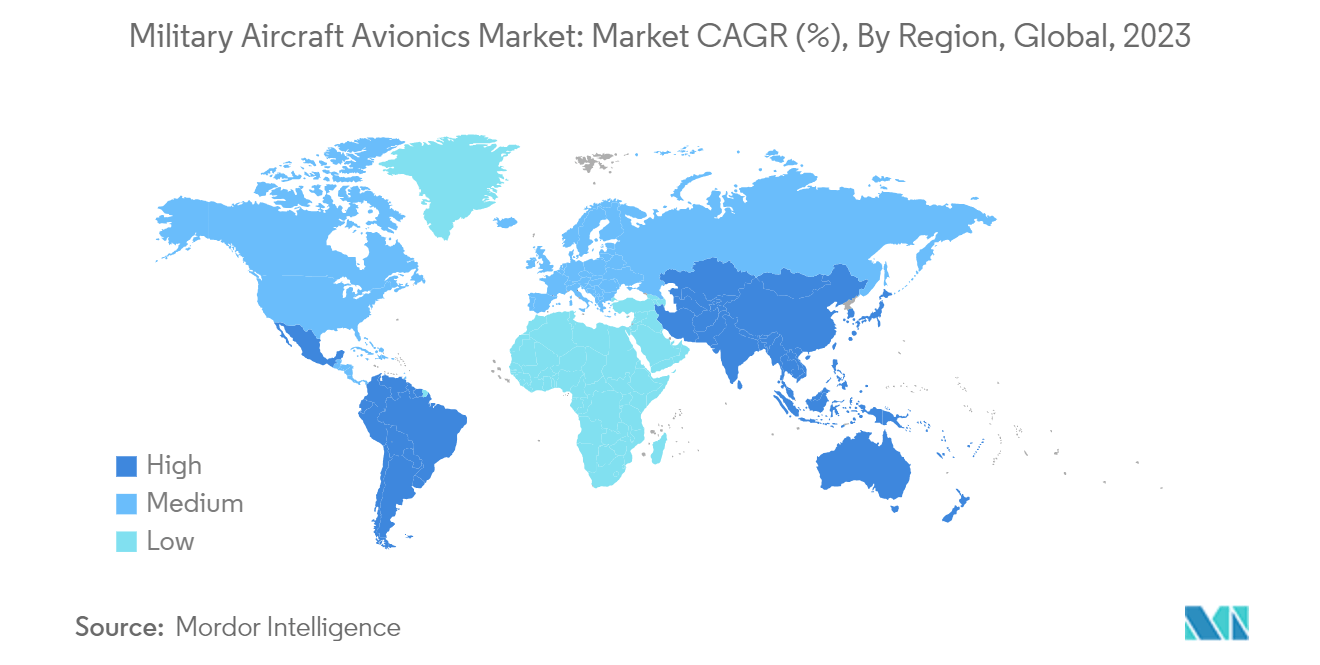
Military Aircraft Avionics Industry Overview
The market for military aircraft avionics is semi-consolidated, with only a few players accounting for most of the market share. RTX Corporation, Lockheed Martin Corporation, Thales, BAE Systems PLC, and Northrop Grumman Corporation are some of the prominent players in the market. The key players enter long-term contracts with aircraft OEMs to provide avionic systems.
Thales is a prominent head-up display (HUD) provider that supports rotary-wing aircraft programs such as NH90, AH-1Z Viper, T129, UH-1Y Venom, Tiger, and Rooivalk helicopters. BAE Systems PLC provides active inceptor systems, electronic warfare suite, vehicle management computers, and electronic components for identification, communication, and navigation systems in the F-35 Lightning II fighter aircraft. The key players invest in research and development and develop advanced products to capture new markets.
Military Aircraft Avionics Market Leaders
-
Lockheed Martin Corporation
-
BAE Systems plc
-
Northrop Grumman Corporation
-
RTX Corporation
-
THALES
*Disclaimer: Major Players sorted in no particular order
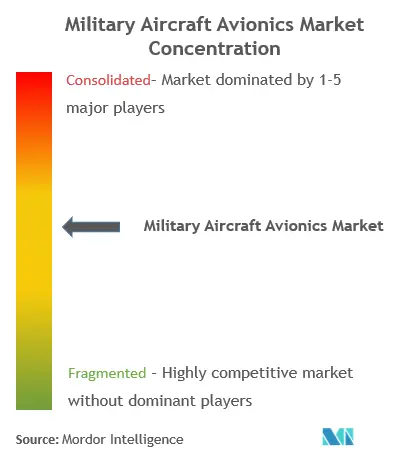
Military Aircraft Avionics Market News
- March 2024: The Indian MoD awarded a contract to Hindustan Aeronautics Limited (HAL) for the mid-life upgrade of 25 Dornier aircraft and associated equipment for the Indian Navy for USD 346.7 million.
- March 2024: South Korea's DAPA announced that it plans to invest USD 2.9 billion to enhance the radar systems and long-range mission capabilities of its F-15K Eagle fleet. Under the program, the aircraft will have the AN/APG-82 electronic scanning radar, BAE Systems' AN/ALQ-250 Eagle Passive Active Warning Survivability System, and a new large-area display in the cockpit to enhance situational awareness.
Military Aircraft Avionics Market Report - Table of Contents
1. INTRODUCTION
- 1.1 Study Assumptions & Market Definition
- 1.2 Scope of the Study
2. RESEARCH METHODOLOGY
3. EXECUTIVE SUMMARY
4. MARKET DYNAMICS
- 4.1 Market Overview
- 4.2 Market Drivers
- 4.3 Market Restraints
-
4.4 Porter's Five Forces Analysis
- 4.4.1 Threat of New Entrants
- 4.4.2 Bargaining Power of Buyers/Consumers
- 4.4.3 Bargaining Power of Suppliers
- 4.4.4 Threat of Substitute Products and Services
- 4.4.5 Intensity of Competitive Rivalry
5. MARKET SEGMENTATION
-
5.1 Subsystem
- 5.1.1 Flight Control System
- 5.1.2 Communication System
- 5.1.3 Navigation System
- 5.1.4 Monitoring System
- 5.1.5 Other Subsystems
-
5.2 Aircraft Type
- 5.2.1 Fixed-wing Combat Aircraft
- 5.2.2 Fixed-wing Non-Combat Aircraft
- 5.2.3 Helicopters
- 5.2.4 Unmanned Aerial Vehicles (UAVs)
-
5.3 Geography
- 5.3.1 North America
- 5.3.1.1 United States
- 5.3.1.2 Canada
- 5.3.2 Europe
- 5.3.2.1 Germany
- 5.3.2.2 United Kingdom
- 5.3.2.3 France
- 5.3.2.4 Russia
- 5.3.2.5 Rest of Europe
- 5.3.3 Asia-Pacific
- 5.3.3.1 China
- 5.3.3.2 India
- 5.3.3.3 Japan
- 5.3.3.4 South Korea
- 5.3.3.5 Rest of Asia-Pacific
- 5.3.4 Latin America
- 5.3.4.1 Brazil
- 5.3.4.2 Mexico
- 5.3.4.3 Rest of Latin America
- 5.3.5 Middle East and Africa
- 5.3.5.1 Saudi Arabia
- 5.3.5.2 United Arab Emirates
- 5.3.5.3 Israel
- 5.3.5.4 Rest of Middle East and Africa
6. COMPETITIVE LANDSCAPE
- 6.1 Vendor Market Share
-
6.2 Company Profiles
- 6.2.1 L3 Harris Technologies Inc.
- 6.2.2 RTX Corporation
- 6.2.3 Lockheed Martin Corporation
- 6.2.4 Northrop Grumman Corporation
- 6.2.5 Thales
- 6.2.6 BAE Systems PLC
- 6.2.7 Honeywell International Inc.
- 6.2.8 Elbit Systems Ltd
- 6.2.9 Cobham Limited
- 6.2.10 Garmin Ltd
- 6.2.11 Moog Inc.
- *List Not Exhaustive
7. MARKET OPPORTUNITIES AND FUTURE TRENDS
** Subject To AvailablityMilitary Aircraft Avionics Industry Segmentation
Avionics systems in an aircraft include communications, display, and management of multiple systems, navigation, and other systems fitted to the aircraft to perform individual functions. Military avionics systems include multiple electronic systems fitted onboard military aircraft to perform various functions.
The military aircraft avionics market is segmented into subsystems, aircraft types, and geography. By subsystem, the market is divided into flight control systems, navigation systems, communication systems, monitoring systems, and other subsystems. The other subsystems segment includes health terrain awareness and warning systems, monitoring/management systems, and weather systems. By aircraft type, the market is segmented into fixed-wing combat aircraft, fixed-wing non-combat aircraft, helicopters, and unmanned aerial vehicles (UAVs). Also, the report covers the sizes and forecasts for the military aircraft avionics market in major countries across different regions. For each segment, the market size is provided in terms of value (USD).
| Subsystem | Flight Control System | |
| Communication System | ||
| Navigation System | ||
| Monitoring System | ||
| Other Subsystems | ||
| Aircraft Type | Fixed-wing Combat Aircraft | |
| Fixed-wing Non-Combat Aircraft | ||
| Helicopters | ||
| Unmanned Aerial Vehicles (UAVs) | ||
| Geography | North America | United States |
| Canada | ||
| Geography | Europe | Germany |
| United Kingdom | ||
| France | ||
| Russia | ||
| Rest of Europe | ||
| Geography | Asia-Pacific | China |
| India | ||
| Japan | ||
| South Korea | ||
| Rest of Asia-Pacific | ||
| Geography | Latin America | Brazil |
| Mexico | ||
| Rest of Latin America | ||
| Geography | Middle East and Africa | Saudi Arabia |
| United Arab Emirates | ||
| Israel | ||
| Rest of Middle East and Africa |
Military Aircraft Avionics Market Research FAQs
How big is the Military Aircraft Avionics Market?
The Military Aircraft Avionics Market size is expected to reach USD 37.14 billion in 2024 and grow at a CAGR of 3.94% to reach USD 45.05 billion by 2029.
What is the current Military Aircraft Avionics Market size?
In 2024, the Military Aircraft Avionics Market size is expected to reach USD 37.14 billion.
Who are the key players in Military Aircraft Avionics Market?
Lockheed Martin Corporation, BAE Systems plc, Northrop Grumman Corporation, RTX Corporation and THALES are the major companies operating in the Military Aircraft Avionics Market.
Which is the fastest growing region in Military Aircraft Avionics Market?
Asia Pacific is estimated to grow at the highest CAGR over the forecast period (2024-2029).
Which region has the biggest share in Military Aircraft Avionics Market?
In 2024, the North America accounts for the largest market share in Military Aircraft Avionics Market.
What years does this Military Aircraft Avionics Market cover, and what was the market size in 2023?
In 2023, the Military Aircraft Avionics Market size was estimated at USD 35.68 billion. The report covers the Military Aircraft Avionics Market historical market size for years: 2019, 2020, 2021, 2022 and 2023. The report also forecasts the Military Aircraft Avionics Market size for years: 2024, 2025, 2026, 2027, 2028 and 2029.
Military Aircraft Avionics Industry Report
Statistics for the 2024 Military Aircraft Avionics market share, size and revenue growth rate, created by Mordor Intelligence™ Industry Reports. Military Aircraft Avionics analysis includes a market forecast outlook to 2029 and historical overview. Get a sample of this industry analysis as a free report PDF download.



